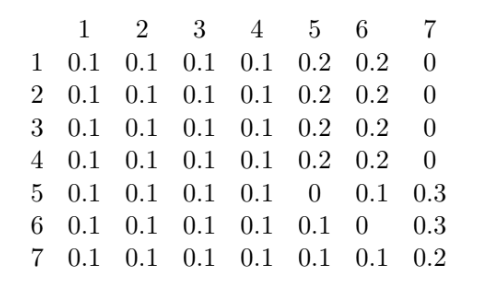Model: Amusement Park Queues (AMUSEMENT)¶
Description:¶
This model simulates an amusement park with 7 attractions. Visitors arrive at each attraction according to a poisson distribution with a rate \(\gamma_i = 1\), \(i = 1,. . . , 7\). Each attraction can only take one visitor at a time, while others wait in a queue with capacity \(c_i\). If a visitor finds a queue full, they will immediately leave the park.
After visiting each attraction, a visitor leaves the park with probability 0.2. Otherwise, the visitor goes to another attraction according to the transition matrix:

The time that a visitor spends at an attraction follows an Erlang distribution with shape parameter \(k = 2`\) and rate \(\lambda = 9\). The park opens at 9AM and closes at 5PM, and time is measured in minutes. When the park closes, all visitors in the queue leave immediately.
Sources of Randomness:¶
There are 3 sources of randomness in this model:
The arrival rate of visitors as a poisson distribution with rate of 1 for all \(i = 1, . . . , 7\).
The transition probabiliyt matrix that visitors follow after visiting each attraction.
The time spent at each attraction as an Erlang distribution with the shape parameter \(k = 2\) and rate = 9.
The Erlang distribution is the distribution representing a sum of \(k\) independent exponential variables with mean \(1/\lambda\) each. It is a special case of the gamma distribution wherein the shape of the distribution is discretized. The probability density function of the Erlang distribution is
\(f(x;k,\lambda) = \frac{\lambda^{k}x^{k-1}e^{-\lambda x}}{(k-1)!} \quad for \ x, \beta >= 0\)
where \(k\) is the shape parameter, \(\lambda\) is the rate parameter.
Alternatively, the pdf can be expressed as
\(f(x;k,\beta) = \frac{x^{k-1}e^{-x/\beta}}{\beta^k(k-1)!} \quad for \ x, \beta >= 0\)
where \(\beta\) is the scale parameter, which is the reciprocal of the rate parameter.
Note: In this model, Erlang variates are generated through the gamma distribution with the scale (\(\beta:\)) parameter set to 1/9.
Accordingly, the reciprocal of desired rate values should be used in the erlang_scale parameter.
Model Factors:¶
park_capacity: The total number of visitors waiting for attractions that can be maintained through park facilities, distributed across the attractions.
Default: 350
number_attractions: The number of attractions in the park.
Default: 7
time_open: The number of minutes per day the park is open.
Default: 480
erlang_shape: The shape parameter of the Erlang distribution for each attraction duration.
Default: [2, 2, 2, 2, 2, 2, 2]
erlang_scale: The scale parameter of the Erlang distribution for each attraction duration (reciprocal of the rate value).
Default: [1/9, 1/9, 1/9, 1/9, 1/9, 1/9, 1/9]
depart_probabilities: The probability that a visitor will depart the park after visiting an attraction.
Default: [0.2, 0.2, 0.2, 0.2, 0.2, 0.2, 0.2]
queue_capacities: The capacity of the queues for the attractions based on the portion of facilities allocated.
Default: [50, 50, 50, 50, 50, 50, 50]
arrival_gammas: The gamma values for the poisson distributions dictating the rates at which visitors entering the park arrive at each attraction.
Default: [1, 1, 1, 1, 1, 1, 1]
transition_probabilities: The transition matrix that describes the probability of a visitor visiting each attraction after their current attraction.
Responses:¶
total_departed: The total number of visitors to leave the park due to full queues.
percent_departed: The percentage of visitors to leave the park due to full queues.
average_number_in_system: The time average of the number of visitors in the system.
attraction_utilization_percentages: The percent utilizations for each attraction.
References:¶
This model is adapted from the article: Vill’en-Altamirano, J. (2009). Restart Simulation of Networks of Queues with Erlang Service Times. Proceedings of the 2009 Winter Simulation Conference.
Optimization Problem: Minimize Total Departed Visitors (AMUSEMENT-1)¶
Decision Variables:¶
queue_capacities
Objectives:¶
Minimize total number of departed visitors.
Constraints:¶
park_capacity = 350
\(\sum_{i=1}^{7}\) queue_capacities = park_capacity
queue_capacities \(\ge\) 0
Problem Factors:¶
Budget: Max # of replications for a solver to take.
Default: 1000
Fixed Model Factors:¶
N/A
Starting Solution:¶
queue_capacities = [50, 50, 50, 50, 50, 50, 50]
Random Solutions:¶
Generate a solution uniformly from a space of vectors of length 7 that sum up to 350.
Optimal Solution:¶
unknown
Optimal Objective Function Value:¶
unknown